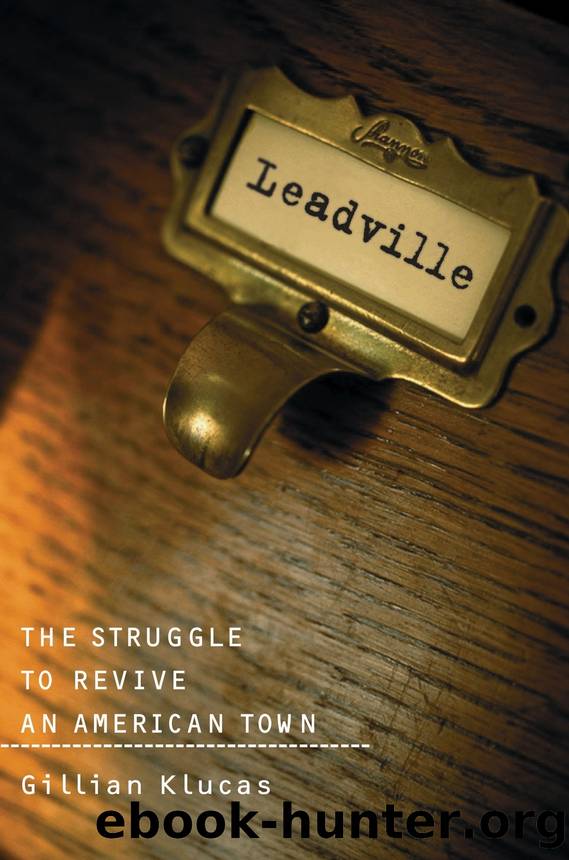Leadville: The Struggle to Revive an American Town by Gillian Klucas

Author:Gillian Klucas [Klucas, Gillian]
Language: eng
Format: epub
Tags: history, General, United States, 19th Century, 20th Century, nature, Environmental Conservation & Protection
ISBN: 9781559633857
Google: -DqdQ_bJ60UC
Publisher: Island Press
Published: 2004-11-05T23:43:09.300775+00:00
12
Moving Yellow Iron
Malta Gulch, a little gully filled with lodgepole pines and tailing piles, begins on the western edge of Leadville and slopes gently downhill for three miles before joining California Gulch near the Arkansas River. The placer miners had already combed the gulch searching for gold by the time Louis Pierre Bochatay had looked upon the small homestead of log structures at the bottom of the gulch and envisioned his future. In 1883, he left the sweltering charcoal kilns that supplied the smelter furnaces with fuel, moved his wife and six children to the little farm, plowed a kidney-shaped field of hay in the pine forest and went back to being a dairy farmer, as he had once been in his native Switzerland.
Unlike the pastoral setting of rural Switzerland, however, the Bochatay farm in the New World, situated on the edge of Malta, a railroad town destined to disappear in the coming century, was encircled by belching smelters and bordered by a railroad track. Nevertheless, Louis Bochatay was a farmer once again, selling milk to the miners in town like his neighbor Henry Smith a few miles down the valley. When Louis passed away less than twenty years later, his two sons ran the Pioneer Dairy until the early 1920s, when they too both died as relatively young men. The farm soon fell into disuse and the old farm buildings were vandalized and destroyed in the late 1930s, before the farmland was inherited by Ivy Rose, a granddaughter of Louis.
In 1943, the Ore and Chemical Company built a mill in Malta Gulch upstream of the Bochatay Farm. Under the noses of the United States government and the Leadville citizenry, the New Yorkâbased company, secretly run by Germans, began shipping molybdenum on the sly to Nazi Germany to help in the war against the Allies. In August 1946, the federal government shut down the Leadville operation and appropriated the company under the Trading with the Enemy Act. By that time, the mining company had deposited a huge amount of mill tailings behind a series of low berms that regularly collapsed, washing six hundred thousand tons of tailings down the gulch and across the Bochatay pasture.
Every year, when the tax bill arrived, Ivy and her husband, a moly miner, fought over their âdamn worthless property,â but for the next forty years, Ivy won the arguments, and she held onto the Bochatay Farm while the rest of Malta Gulch was bought and sold several times over. By the time the EPA arrived, much of the gulch had ended up with the Leadville Corporation, a small company run since the 1940s by Robert Risk, a dentist from Indiana. After the war, Leadville Corpâs prospects collapsed and in 1974 they leased their claims, equipment, and mill to Day Mines, which in 1981 merged into the much larger Hecla Mining Company. The Hecla/Day operations left behind another 680,000 tons of tailings until it closed its operations and dropped its lease in 1984. A few years
Download
This site does not store any files on its server. We only index and link to content provided by other sites. Please contact the content providers to delete copyright contents if any and email us, we'll remove relevant links or contents immediately.
| Automotive | Engineering |
| Transportation |
Machine Learning at Scale with H2O by Gregory Keys | David Whiting(4179)
Never by Ken Follett(3790)
Urban Outlaw by Magnus Walker(3340)
OPNsense Beginner to Professional by Julio Cesar Bueno de Camargo(3251)
Sapiens and Homo Deus by Yuval Noah Harari(2987)
Will by Will Smith(2792)
A Short History of Nearly Everything by Bryson Bill(2629)
Hooked: A Dark, Contemporary Romance (Never After Series) by Emily McIntire(2500)
Rationality by Steven Pinker(2291)
Borders by unknow(2229)
The Becoming by Nora Roberts(2087)
Holy Bible (NIV) by Zondervan(2086)
The One Percenter Encyclopedia by Bill Hayes(1787)
HBR's 10 Must Reads 2022 by Harvard Business Review(1777)
Freedom by Sonny Barger(1771)
A Short History of War by Jeremy Black(1762)
Five Ways to Fall by K.A. Tucker(1700)
Go Tell the Bees That I Am Gone by Diana Gabaldon(1687)
Girls Auto Clinic Glove Box Guide by Patrice Banks(1685)
